Western Region: Hawaii: USA
Hawaii is made up of a chain of 132 islands. The islands were created by volcanoes erupting at the floor of the Pacific Ocean. More than three million people visit Hawaii each year. Many of the guests are greeted with flowered necklaces called leis. They are also greeted with a special Hawaiian word that means hello.
Pu’uhonua o Honaunau National Historical Park 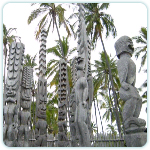
See reconstructed burial temples and canoe sheds at this place of refuge in ancient Hawaiian culture. Spanning 180 acres of idyllic oceanfront land, this heavenly park preserves a revered place of refuge and profound significance in ancient Hawaiian culture.
According to island natives, a visit to a pu’uhonua had the power to shelter those fleeing from battle, as well as absolve those who broke a kapu—one of the sacred laws that governed everything.
To break a kapu was to incur the wrath of the gods, with potential consequences from lava flows to tsunamis, not to mention certain death. Upon reaching this sanctuary, kapu breakers were purified by a priest and spared further punishment.
Meticulously restored, the royal compound includes exquisitely carved wooden images, a mausoleum for the Kamehameha dynasty, and the impressive wall built stone by stone without mortar.
Beyond its sublime natural beauty and mana, or spiritual power, the park offers abundant interactive cultural opportunities. On a 30-minute self-guiding trail, you will see many archaeological sites, including reconstructed burial temples and canoe sheds.
Watch your head—the ceiling is low—and flashlights are recommended. Ask at the visitors center for a backcountry trail guide. Open year-round. Admission charged. www.nps.gov/puho (808) 328-2326
Ke’e Beach and Kalalau Trail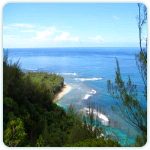
Ke’e Beach is protected by an offshore reef and, unlike other beaches in the vicinity, provides safe wading, swimming, snorkeling, and scuba diving even in winter.
Ke’e is part of Haèna State Park, a scenic wildland that includes the Waikapalae and Waikanaloa wet caves, which contain pools of glowing green water. Hawaiian legend says that chiefs of old used to gather here.
There’s much to see, and you can camp nearby, at Hanakoa, and Kalalau, but the real attraction is Kalalau Trail, used since prehistoric times to reach Kalalau Valley, 11 miles away. Beginning at Ke’e Beach, the trail follows the spectacular Na Pali Coast.
You can backpack and make an overnight stop at Kalalau or make a day trip to Hanakapi’ai Beach. Side trails lead to waterfalls and lush valleys, and hikers won’t go hungry. The way is lined with delicious wild yellow guavas.
Swimming is not recommended, and in wet weather hiking the entire trail calls for caution. Open year-round during daylight hours. www.hawaiistateparks.org/parks/ Kauai/index.cfm?park_id=8 (808) 274-3444
Wailua Falls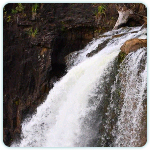
Even if you knew there was a natural wonder on the scale of Wailua Falls in the vicinity, you’d never dream this prosaic little road past a Buddhist cemetery and through four miles of waving sugarcane would be the way to reach it.
The double torrent that feeds the falls (wai means “fresh water,” lua, “two”) drops 80 feet to a flower-ringed pool. The plunge is especially dramatic after heavy mountain rains—a comparatively frequent occurrence, since 5,000-foot Mount Waialeale, which dominates the center of Kauai, is considered one of the wettest spots in the world, with a yearly rainfall of almost 400 inches.
Unfortunately, there’s no safe way to climb down to the base of the falls, so your view is limited to what can be seen from just one spot. Open year-round. www.hawaiiweb.com/kauai
Nu’uanu Pali State Wayside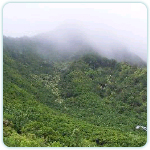
Although this dramatic view over the mountains, hills, and bays of windward Oahu is at its magnificent best in the morning, you might want to time your visit for lunch or later to avoid the crowds and tour buses.
The viewing platform, enlarged to accommodate the crowds, also detracts from the area’s original wilderness atmosphere, so descend to the ledge just below it (about 1,000 feet above sea level).
Because the lookout is at a low point in the Koolau Range crest, trade winds drive so forcefully through the gap that you can virtually lean into them. There are stories of would-be suicides blown right back onto the top of the pali (cliffs).
But watch out, because when the wind is blowing in the opposite direction, it can be dangerous. When the battle of Nu’uanu was fought here in 1795, pitting Kamehameha I against Kalanikupule, king of Oahu, warriors were said to have been driven—or blown—over the pali. Open year-round. www.hawaiistateparks.org/parks/oahu (808) 587-0300
 Pu’u Ualaka’a State Wayside
Pu’u Ualaka’a State Wayside
Many malihini (newcomers) miss this glorious view because it’s not easy to find. But look for Makiki St. on a detailed map and you’ll see that it connects from a scenic drive to this mountaintop wayside. A second, longer route—Tantalus Dr. —begins farther west, off Puowaina Dr. Honolulu residents usually ascend by one drive and descend by the other.
The heights tend to be much cooler than the lowlands, and the wayside is an ideal spot to visit on a hot summer day. When you get here, the expected facilities make it seem like just another park: trees, grass, picnic tables, and a comfort station. But then there’s the view: No other area open to the public boasts anything like it.
The city is spread out before you, from Pearl Harbor and the airport in one direction to Diamond Head and Koko Head in the other. Pu’u ‘Ualaka’a (known locally as Round Top) means “hill of the rolling sweet potatoes.” It got its name, according to the story, because Kamehameha I ordered sweet potatoes to be planted here—and when they were dug up, they rolled down the hill. Open dawn to dusk year-round. www.hawaiistate parks.org/parks/oahu (808) 587- 0300
St. Joseph’s Church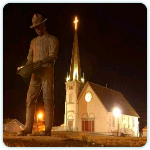
Father Damien ministered to needs beyond those of the Kalaupapa leprosy colony. He also built four churches for his parishioners on Molokai’s uplands, or “topside,” and made his ecclesiastical rounds by horseback.
St. Joseph’s, built in 1876, is a white one-room building with a churchyard that contains several graves. One small but poignant stone is incised partly in Hawaiian: “Margarita Kameekua, hanau Honolulu March 1, 1914, make Kamalo February 27, 1915.” Hanau means “born,” and make means “died.”
A lifesize black metal statue of Father Damien stands just outside the tiny church, which, like St. Philomena’s at Kalawao, is kept in good repair but used only for special occasions. Farther east along Rte. 450, near Mapulehu Stream, is Our Lady of Sorrows (1874), another of Father Damien’s topside churches. Open year-round. www.gohawaii.about.com/library/gallery/ bleast_molokai_65.htm (808) 553-5220
